Portal
By now I’m sure you’ve seen the Portal videos all over the net so you’ll have some idea of what Portal is all about. But what you probably don’t know is that Portal is a standalone game that whilst it uses the Source engine and is set in the Half Life 2 universe, it has bugger all to do with Half Life. That said, Aperture Laboratories, which you’ll discover as you play the game, is a direct competitor with Black Mesa… but I’m not going to go into the subtle references to Half Life here, I’ll let you find those out for yourself.
So the first thing you need to know is that Portal is an out and out platform puzzler. There’s no shooting, no army of bad guys and in fact no-one else in the game except you and, later on, some sentry guns. Oh, and you only have one gun, the Aperture Laboratories Portal Gun, which in the game Aperture seem quite proud and in real life Valve should be thoroughly congratulated on, bought a big steak dinner and a full body lap dance with all the, ahem, ‘extras’.
Simply put, it’s superb.
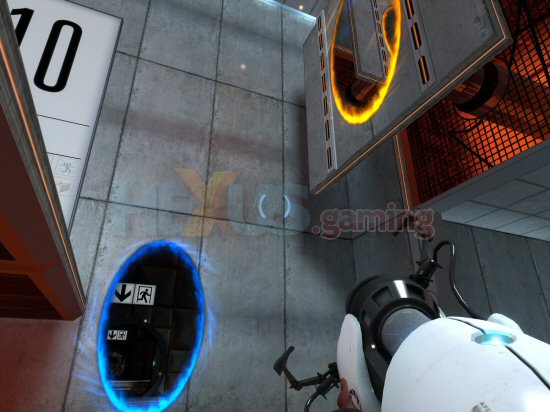 Click for larger image
Click for larger imageYou see, it’s not just the Portal Gun and what it can do that is so brilliant, It’s the fact that Valve have looked at the medium they’re working in and taken advantage of the fact it’s a world where you can literally do anything you want. Ok, games have been doing this for years as we’ve fought seven-headed hydra, flown magic carpets, raced hovering supersonic ships and all that stuff.
But where Valve differ with Portal is that they’ve taken an idea that would be impossible in real life and then created it in a game world that reacts as a real life world. To put it another way, most games seek to create realistic worlds for us to play in. Valve have that with the Source engine, and now they’re asking ‘what if’ with stuff that is nothing more than theories on paper in this, our real world. It’s brilliant.
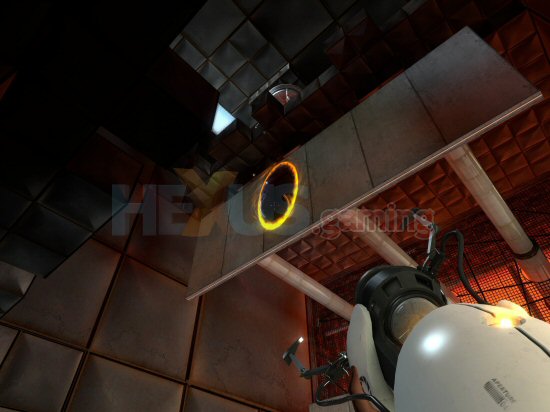 Click for larger image
Click for larger imageTime to explain what Portal is about then. Basically, you’ve got a gun that can create portals on most suitable surfaces. Imagine them as hole you can open up in a wall. But the clever bit is that you need a second portal to come out of, so you create that with the gun too. Step into the first portal and you come out of the other... or vice versa, it doesn’t matter, you can go either way.
Where it gets very clever is that you can place a portal on the floor and then have the other one on a wall, it doesn’t matter where. But the really clever bit is that the portals you create act just like a true doorway would… momentum, velocity, vector… all are conserved as you pass though a portal. And this, well, it’s just mind boggling.
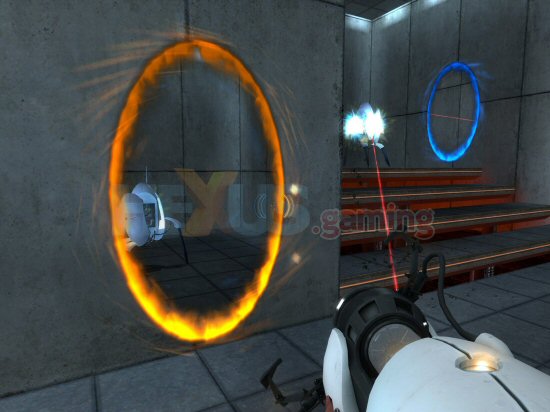 Click for larger image
Click for larger imageWhat’s more, Valve have designed Portal to take advantage of those very facts. In fact, some of the levels in Portal require you to make use of these very concepts. Imagine you have to cross a chasm. You could just make a portal next to you and then create an exit on a wall over on the other side of the chasm and then just step through. Easy. But what if the wall over there doesn’t allow a portal to be made? If you could get up enough speed you could jump the gap but how do you do that? The answer is to create a portal high up on the wall behind you, then another one on the floor in front of you. Step through and you’ll fall straight down out of the portal up on the wall. But here’s the clever bit, you’ll then have masses of speed from falling and, if you’ve placed the portal on the floor in the right place, you’ll fall back through it. But now you’ll have loads of speed which means that as you exit the portal up on the wall, you’ll be flung horizontally much further… and hopefully across the chasm.
And, seeing as you can create two portals independently of each other, you can create a portal as you drop, moving your entry portal to where you'll land as you build up speed. Eventually you'll be going quick enough to leap frog across vast chasms or gradually ping yourself higher and higher to reach ledges way above you. Frankly, this is gaming brilliance.
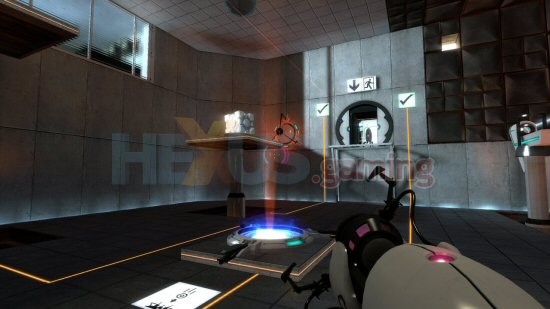 Click for larger image
Click for larger imageThat Valve have released Portal as a standalone game and not included it as a new weapon in the full Half Life 2: Episode Two section is perhaps a testament to how radically this affect gameplay and game design. In Portal you’re always within a controlled environment. Imagine the game design issues you’d have if you could just portal across levels in a Half Life 2 map… it’d be a nightmare to still deliver a satisfying game experience.
That said, Portal takes place within the Aperture Laboratories labs, which are mentioned for the first time in Half Life 2: Episode 2… so maybe Episode 3 will have us mucking about with portals?
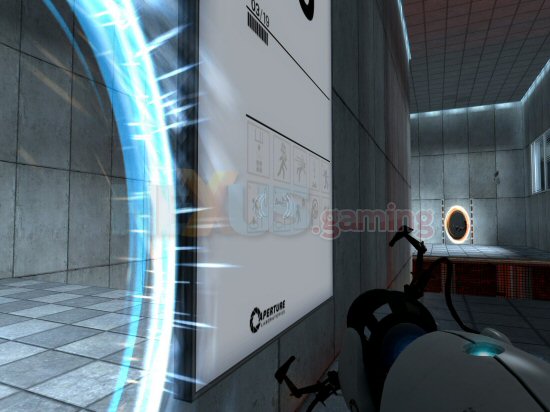 Click for larger image
Click for larger imageOh, one more thing… when you’re playing Portal, you know that bit with the fire pit that appears to be the end of the game? It isn’t… and I’ll say no more than that.









